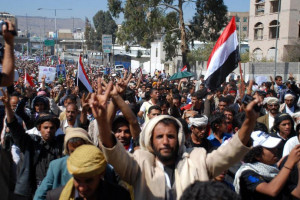
According to the Sana’a’s position, the Houthis are pursuing a strategic goal of creating a “state within a state” in Yemen, just like “Hezbollah” did in Lebanon. They are planning to establish control over the northern part of the country (including the capital’s international airport) and to gain access to the Red Sea in the Haja governorate, which would allow them to obtain shipments of guns smuggled from Iran and gain easy access to the oil fields of the Al Jawf governorate. The calculations show that the Shiite rebels won’t go further south since there’s no places of residence Zaidiyya (Yemeni Shiites which constitute the backbone of the Houthis movement). At the same time, it is unlikely that they are planning to overtake the capital, where the majority of the population is Sunni,since they may got caught in the street fights. But should they prevail they will be able to negotiate on the special status of the capital on their own terms without even taking it. But things may change if the Houthis will come to an agreement with the former President Ali Abdullah Salih who still enjoys full support of a number of influential tribes in Yemen.
The White House fears that this scenario can endanger its diplomatic mission and the US citizens will fall victims of the Houthis as it was the case in 2012. Therefore it tries to mobilize its NATO and EU allies in order to consolidate their political efforts against the possible capture of Sana’a. By the rebels. However, they have managed to obtain the support of Saudi Arabia and other GCC countries so far, while even London, the closest of the US allies in Europe has gone as far as to issue calls for restraint to both sides.
Still the Americans and Saudis are spreading rumors about the impending fate of Sana’a in the hands of the Houthis. They even have allegedly learned that that the Houthis allies have been provided with weapons inside Sara’a, on the heights dominating the Yemeni international airport. Meanwhile, the leaders of the rebellion say the opposite – they were not intended to start the clashes, so it’s “Al-Islah” to be blamed for the recent aggravation of the situation, because this party has fully recognized the ceasefire agreement of June 23 and failed to sign another settlement plan, that had been drafted by the President Abdrabuh Mansour Hadi personally in the presence of the Houthis leaders. Moreover, at least in their rhetorics, the leaders of the rebellion are in favor of the continuation of the national reconciliation process. However, they claim that the regular army aircraft has been bombarding their positions near the city of Amran, thus provoking retaliatory actions. Still the Zaidiyya leader Abdul Malik al-Houthi has ordered the rebel troops not to respond to this course of action. However the rebellion has already demonstrated its power by a massive protest in Sana’a that took place on July 11 against Israeli attacks on Gaza.
So far, one thing is clear – the situation in Yemen is deteriorating at a rapid pace which may lead to the subsequent transfer of the armed confrontation to Sana’a. And this may as well be followed by the fracturing of the country, since the south has been waiting for a pretext to secede in order to be able to create its own state with the capital in Aden. While having significant oil and gas reserves, as well as its own political structures, the south is capable of establishing a viable nation. In this case the northern part of the present-day Yemen will face an uncertain fate since the Shiite Islamists supported by Iran will most likely be able to change the country’s political system, after which they can start their quest for influence in the neighboring countries, primarily in the areas of the Yemeni tribes residence in Saudi Arabia, near the border with Yemen.
So it seems that Washington must suffer one more defeat in the Arab world, this time in Yemen. The developments that were provoked the “Arab spring” and the US interference in the state’s affairs are able to create yet another hotbed of instability in the Arabia. This can potentially endanger the stability of the principal US ally in the region – Saudi Arabia. Yemen can be added to the ranks of Egypt, Libya, Syria, Iraq — all of which is the result of the Obama administration’s foreign policy in the Arab world. One can only guess which country will fall the victim of the American failures and stupidity in the region?
Viktor Titov, Ph.D in Historical Sciences and political commentator on the Middle East, exclusively for the online magazine New Eastern Outlook
